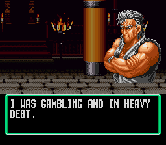
« PREVIOUS ENTRY
Batman
NEXT ENTRY »
Automatic prayer wheel

Everyone who plays video games knows the fun part about “finishing” a game: You get to watch some sort of special feature while the credits roll. (As an aside, isn’t it weird that video games only put the credits at the end of the game? Many television shows and movies begin with at least some mention of the director and even the producer — but video games generally only refer to the company that produced it. If you want to find out who’s responsible for the fun you’re having, you have to play so well that you complete the game; the knowledge is your reward. That’s a really weird relationship between the artist and the audience.)
But anyway, since many games are either too hard to complete — or too boring to bother — the fine folks at the Video Game Museum have collected screenshots from the final moments of “completed” games. They’re hilariously overwrought yet often oddly touching. Since many of these games are old, SNES-style titles, the creators couldn’t use lavish animated sequences. Mostly, they just use static images with text beneath.
But here’s the thing: Given how emotionally purple most of these stories are, they wind up feeling precisely like silent films — Kabuki-like, stylized drama delivered via text-box speech bubbles. A lovely example of that is the final sequence to the SNES game Art of Fighting, where the combatants finally unveil their long-lost father and have a tearful reunion. (That’s the father in the screenshot above.)
Though I’m a huge game fan, I’ve never really agreed with the argument that games are “art”. They’re “play”, which is an entirely different — and entirely nifty — category of human creativity. (Games might be artistic, but that’s different from being art.) Nonetheless, these little dramatic sequences are a totally wonderful reminder of what dramatic range you can squeeze out of the most retrograde tools. These guys were just desperate to tell these huge, Kurosawa-grade epic stories, but could only use grainy 8-bit game engines to do so. It reminds me of the genuis of David Rees, who has intentionally embraced these limitations in Get Your War On — where the use of static, repetitive clip-art is the prime reason the strip is funny.
(Thanks to Memepool for finding this site!)
I'm Clive Thompson, the author of Smarter Than You Think: How Technology is Changing Our Minds for the Better (Penguin Press). You can order the book now at Amazon, Barnes and Noble, Powells, Indiebound, or through your local bookstore! I'm also a contributing writer for the New York Times Magazine and a columnist for Wired magazine. Email is here or ping me via the antiquated form of AOL IM (pomeranian99).

ECHO
Erik Weissengruber
Vespaboy
Terri Senft
Tom Igoe
El Rey Del Art
Morgan Noel
Maura Johnston
Cori Eckert
Heather Gold
Andrew Hearst
Chris Allbritton
Bret Dawson
Michele Tepper
Sharyn November
Gail Jaitin
Barnaby Marshall
Frankly, I'd Rather Not
The Shifted Librarian
Ryan Bigge
Nick Denton
Howard Sherman's Nuggets
Serial Deviant
Ellen McDermott
Jeff Liu
Marc Kelsey
Chris Shieh
Iron Monkey
Diversions
Rob Toole
Donut Rock City
Ross Judson
Idle Words
J-Walk Blog
The Antic Muse
Tribblescape
Little Things
Jeff Heer
Abstract Dynamics
Snark Market
Plastic Bag
Sensory Impact
Incoming Signals
MemeFirst
MemoryCard
Majikthise
Ludonauts
Boing Boing
Slashdot
Atrios
Smart Mobs
Plastic
Ludology.org
The Feature
Gizmodo
game girl
Mindjack
Techdirt Wireless News
Corante Gaming blog
Corante Social Software blog
ECHO
SciTech Daily
Arts and Letters Daily
Textually.org
BlogPulse
Robots.net
Alan Reiter's Wireless Data Weblog
Brad DeLong
Viral Marketing Blog
Gameblogs
Slashdot Games